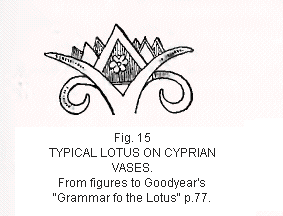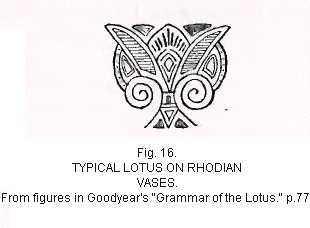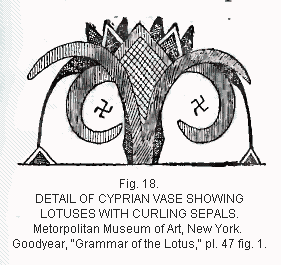

The Swastika
Definitions, Description & Origin
Prof. W. H. Goodyear, of New York, has lately (1891) published an elaborate quarto work entitled "The Grammar of the Lous: A New History of Classic Ornament as a Development of sun Worship." (3) It comprises 408 pages, with 76 plates, and nearly a thousand figures. His theory develops the sun symbol from the lotus by a series of ingenious and complicated evolutions passing through the Ionic style of architecture, the volutes and spirals forming meanders or Greek frets, and from this to the Swastika. The result is attained by the following line of argument and illustrations:
The lotus was a "fetish of immemorial antiquity and has been worshiped in many countries from Japan tot he straits of Gibraltar;" it was a symbol of "fecundity," "life," "immortality," and of "resurrection," and has a mortuary significance and use. But its elementary and most important signification was as a solar symbol. (4)
He describes the Egyptian lotus and traces it through an innumerable number of specimens and with great variety of form. He mentions many of the sacred animals of Egypt and seeks to maintain their relationship by or through the lotus, not only with each other but with solar circles and the sun worship. (5)
Direct association of the solar disk and lotus are, according to him, common on the monuments and on Phoenician and Assyrian seals; while the lous and the sacred animals, as in cases cited of the goose representing Seb (solar god, and father of Osiris), also Osiris himself and Horus, the hawk and lotus, bull and lotus, the asp and lotus, the lion and lotus, the sphinx and lotus, the gryphon and lotus, the serpent and lotus, the ram and lotus -- all of which animals, and with them the lotus, have, in his opnion, some related signification to the sun or some of his deities. (6)
He is of the opinion that the lotus motif was the foundation of the Egyptian style of architecture, and that it appeared at n early date, say, the fourteenth century B.C. By intercommunication with the Greeks it formed the foundation of the Greek Ionic capital, which, he says, (7) "offers no dated example of the earlier time than the sixth century B.C." He supports this contention by authority, argument, and illustration. He shows (8) the transfer of the lotus motif to Greece, and its use as an ornament on the painted vases and on those from Cyprus, Rhodes, and Melos (fig. 15 ,16, 17).
 Chantre
(9) bites the presence of spirals
similar to those of fig.17, in the terramares of northern Italy and up
and down the Danube, and his fig. 186 (fig. 17) he says represents the
decorating motif, the most frequent in all that part of prehistoric Europe.
He cites "Notes sur les torques on ornaments spirals." (10)
Chantre
(9) bites the presence of spirals
similar to those of fig.17, in the terramares of northern Italy and up
and down the Danube, and his fig. 186 (fig. 17) he says represents the
decorating motif, the most frequent in all that part of prehistoric Europe.
He cites "Notes sur les torques on ornaments spirals." (10)That the lotus had a foundation deep and wide in Egyptian mythology is not to be denied; that it was allied to and associated on the monuments and other objects with many sacred and mythologic characters in Egypt and afterwards in Greece is accepted. How far it extends in the direction contended for by Professor Goodyear, is no part of this investigation. It appears well established that in both countries it became highly conventionalized, and it is quite sufficient for the purpose of this argument that it became thus associated with the Swastika. Figs. 18 and 19 represent details of Cyprian vases and amphora belonging to the Cesnola collection in the New York Metropolitan Museum of Art, showing the lotus with curling sepals among which are interspersed Swastikas of different forms.



ENDNOTES:
1. Trans. Lancaster and Cheshire Antig\q. Soc.,1886. [Back]
2. Haddon, "Evolution in Art," London, 1895, p. 288. [Back]
3. Sampson, Low, Marston & Co., London. [Back]
4. Goodyear, "The Grammar of the Lotus," pp. 4, 5. [Back]
5. Ibid., p. 6. [Back]
6. Goodyear, "The Grammar of the Lotus," pp. 7, 8. [Back]
7. Ibid., p. 71. [Back]
8. Ibid, pp. 74,77. [Back]
9. "Age du bronze," Deuxieme partie, p. 301. [Back]
10. Matériaux pour PHistoire Primitive et Naturelle de l'Homme, 3c ser., viii, p. 6. [Back]
<< Previous Page Next Page >>
© 2004-2007 Northvegr.
Most of the material on this site is in the public domain. However, many people have worked very hard to bring these texts to you so if you do use the work, we would appreciate it if you could give credit to both the Northvegr site and to the individuals who worked to bring you these texts. A small number of texts are copyrighted and cannot be used without the author's permission. Any text that is copyrighted will have a clear notation of such on the main index page for that text. Inquiries can be sent to info@northvegr.org. Northvegr™ and the Northvegr symbol are trademarks and service marks of the Northvegr Foundation.

|